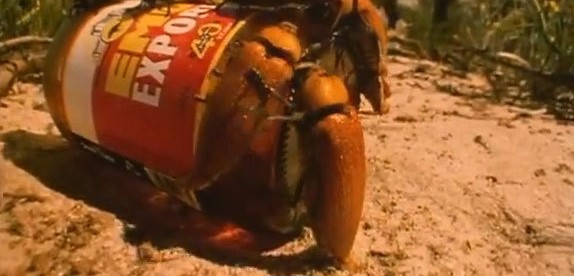Hitting the Bottle

Beer, Benjamin Franklin is (falsely) credited with observing, “is proof that God loves us and wants us to be happy.” By “us,” Franklin meant “people,” one assumes. But what about other species? Take, the Australian jewel beetle. If given a bottle of beer, what will it do?
Well, let’s start with a picture.

That picture (via a BBC Planet Wild video) is of a bottle of Emu, an Australian brand of beer. There’s nothing particularly notable about Emu, at least not to people. But, as you can see above, it’s popular among the jewel beetles. But they’re not trying to drink the beer.
They’re trying to mate with the bottle.
In the 1980s, two biologists — David Rentz and Darryl Gwynne — were out in the field doing research on insects — not on the Australian jewel beetle, but that quickly changed. The area that they were working in was littered (literally) with discarded bottles of Emu-brand beer, and one of the beer bottles had a jewel beetle attached to it. And by “attached,” one means firmly and unshakably — because, as Gwynne told LiveScience, the beetles’ private parts were “clearly prodding away at the back end of the bottle.” And it wasn’t just this one beetle on this one bottle. In most places where Rentz and Gwynne found beetles nearby Emu bottles, the beer was being shtupped by the insects.
The Discovery Channel’s Seeker website explains why beetles wanted to get it on with the glass:
It’s a case of mistaken attraction, because the beer bottles happen to possess all of the features that drive male Australian jewel beetles wild. They’re big and orangey brown in color [just like female Austalian jewel beetles], with a slightly dimpled surface near the bottom (designed to prevent the bottle from slipping out of one’s grasp) that reflects light in much the same way as female wing covers.
For the male beetles, this mistake was more than just a punchline; it could prove fatal, too. Australian Geographic, citing Rentz and Gwynne, notes that the male beetles would keep going and going and going, which means they “could unwittingly starve or exhaust themselves to death.”
Emu, to its credit, changed its bottle design upon learning of the beetles’ plight. As NPR reports, “the little bumps were eliminated to be replaced by smooth glass, the beetles lost all interest in bottles, and life in the Australian west — at least beetle life — went back to normal.”
Bonus fact: Beatle great George Harrison died in 2001 and, a few years later, the city of Los Angeles planted a pine tree in his honor and memory. But in 2013, the George Harrison Tree died — it was, poetically yet tragically, infested with beetles.
From the Archives: Beer Bricks: How Heineken tried to reduce homelessness through beer.
